windshield Ram 1500 2015 Owner's Guide
[x] Cancel search | Manufacturer: RAM, Model Year: 2015, Model line: 1500, Model: Ram 1500 2015Pages: 871, PDF Size: 24.83 MB
Page 422 of 871
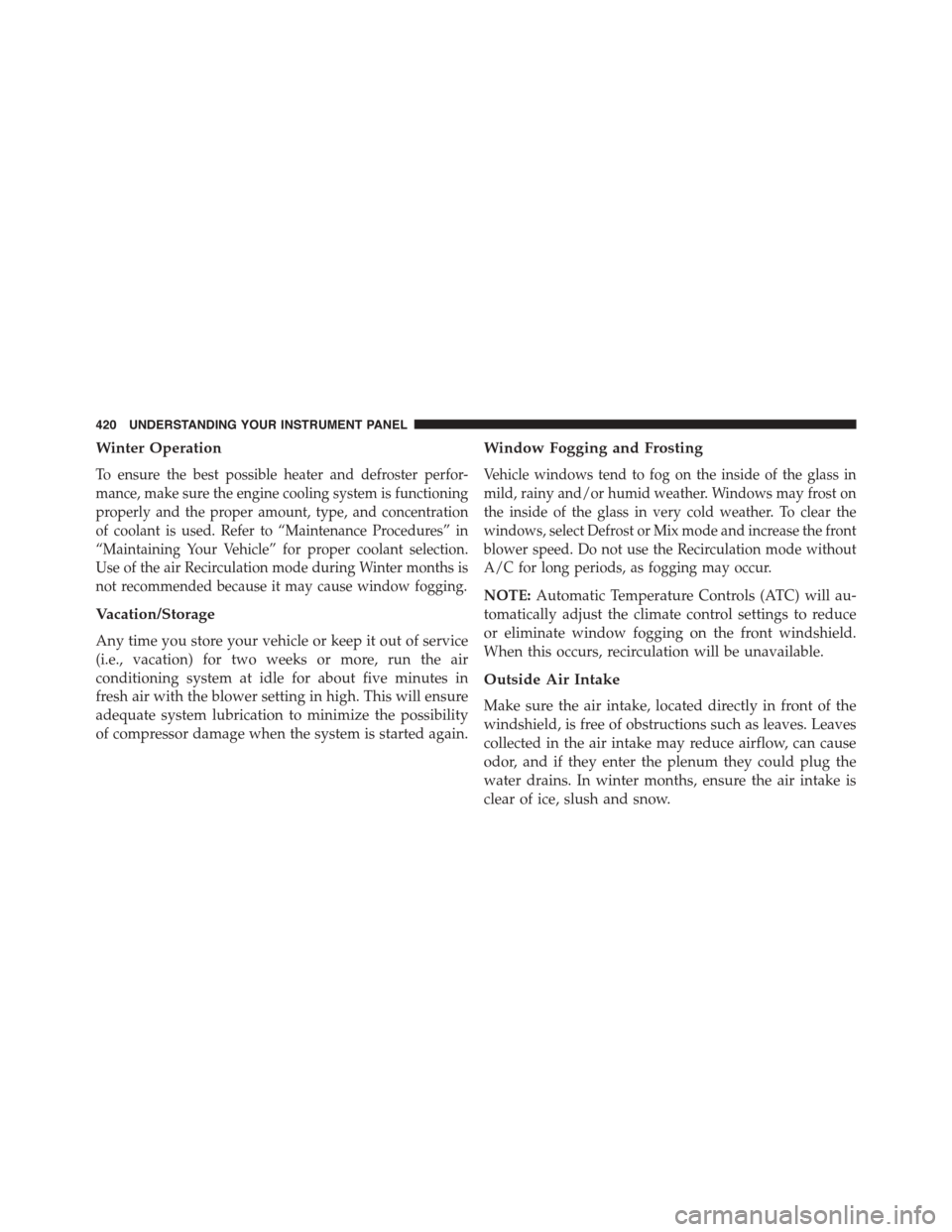
Winter Operation
To ensure the best possible heater and defroster perfor-
mance, make sure the engine cooling system is functioning
properly and the proper amount, type, and concentration
of coolant is used. Refer to “Maintenance Procedures” in
“Maintaining Your Vehicle” for proper coolant selection.
Use of the air Recirculation mode during Winter months is
not recommended because it may cause window fogging.
Vacation/Storage
Any time you store your vehicle or keep it out of service
(i.e., vacation) for two weeks or more, run the air
conditioning system at idle for about five minutes in
fresh air with the blower setting in high. This will ensure
adequate system lubrication to minimize the possibility
of compressor damage when the system is started again.
Window Fogging and Frosting
Vehicle windows tend to fog on the inside of the glass in
mild, rainy and/or humid weather. Windows may frost on
the inside of the glass in very cold weather. To clear the
windows, select Defrost or Mix mode and increase the front
blower speed. Do not use the Recirculation mode without
A/C for long periods, as fogging may occur.
NOTE:Automatic Temperature Controls (ATC) will au-
tomatically adjust the climate control settings to reduce
or eliminate window fogging on the front windshield.
When this occurs, recirculation will be unavailable.
Outside Air Intake
Make sure the air intake, located directly in front of the
windshield, is free of obstructions such as leaves. Leaves
collected in the air intake may reduce airflow, can cause
odor, and if they enter the plenum they could plug the
water drains. In winter months, ensure the air intake is
clear of ice, slush and snow.
420 UNDERSTANDING YOUR INSTRUMENT PANEL
Page 747 of 871
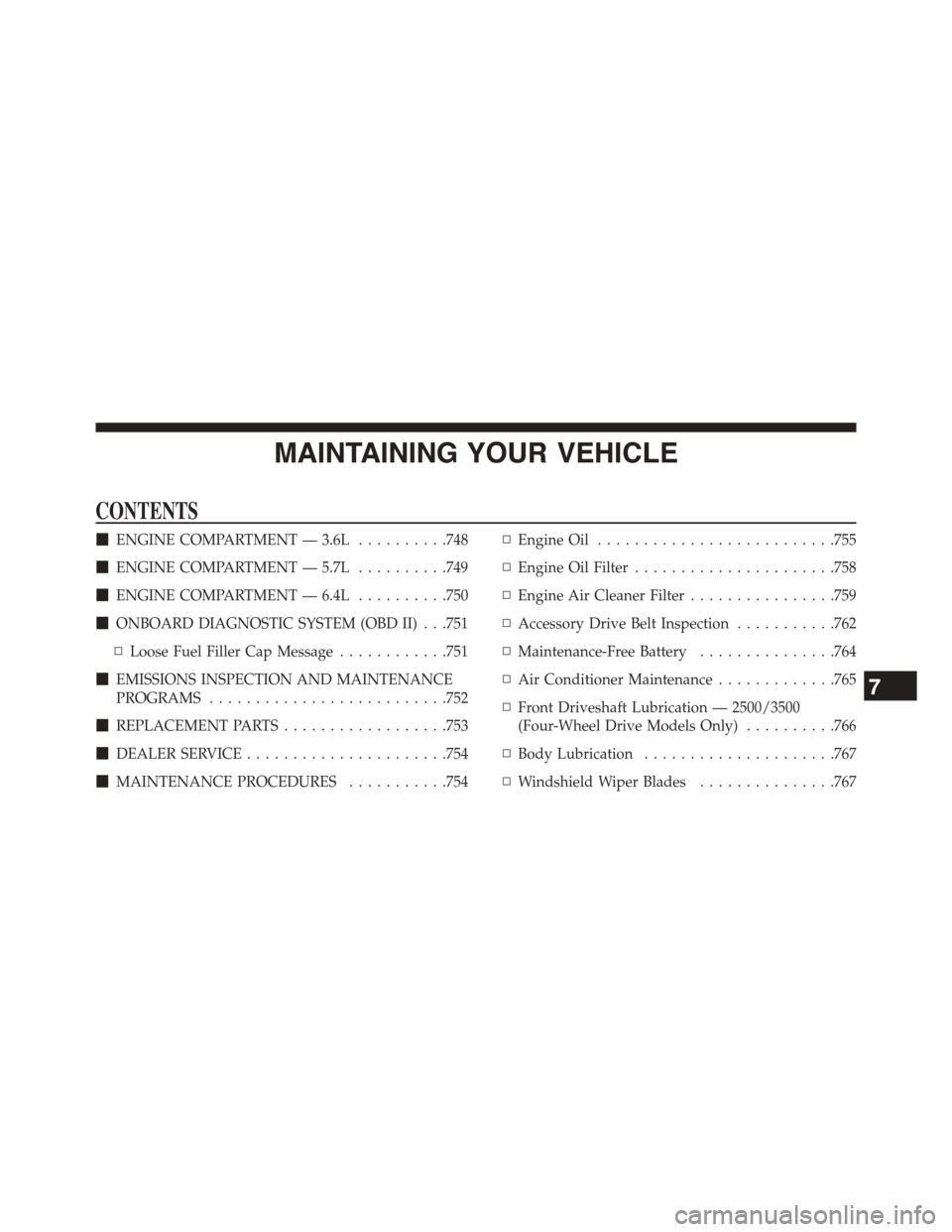
MAINTAINING YOUR VEHICLE
CONTENTS
!ENGINE COMPARTMENT — 3.6L..........748
!ENGINE COMPARTMENT — 5.7L..........749
!ENGINE COMPARTMENT — 6.4L..........750
!ONBOARD DIAGNOSTIC SYSTEM (OBD II) . . .751
▫Loose Fuel Filler Cap Message............751
!EMISSIONS INSPECTION AND MAINTENANCE
PROGRAMS..........................752
!REPLACEMENT PARTS..................753
!DEALER SERVICE......................754
!MAINTENANCE PROCEDURES...........754
▫Engine Oil..........................755
▫Engine Oil Filter......................758
▫Engine Air Cleaner Filter................759
▫Accessory Drive Belt Inspection...........762
▫Maintenance-Free Battery...............764
▫Air Conditioner Maintenance.............765
▫Front Driveshaft Lubrication — 2500/3500
(Four-Wheel Drive Models Only)..........766
▫Body Lubrication.....................767
▫Windshield Wiper Blades...............767
7
Page 769 of 871

Body Lubrication
Locks and all body pivot points, including such items as
seat tracks, door hinge pivot points and rollers, liftgate,
tailgate, decklid, sliding doors and hood hinges, should
be lubricated periodically with a lithium based grease,
such as MOPAR® Spray White Lube to assure quiet, easy
operation and to protect against rust and wear. Prior to
the application of any lubricant, the parts concerned
should be wiped clean to remove dust and grit; after
lubricating excess oil and grease should be removed.
Particular attention should also be given to hood latching
components to ensure proper function. When performing
other underhood services, the hood latch, release mecha-
nism and safety catch should be cleaned and lubricated.
The external lock cylinders should be lubricated twice a
year, preferably in the Fall and Spring. Apply a small
amount of a high quality lubricant, such as MOPAR®
Lock Cylinder Lubricant directly into the lock cylinder.
Windshield Wiper Blades
Clean the rubber edges of the wiper blades and the
windshield periodically with a sponge or soft cloth and a
mild nonabrasive cleaner. This will remove accumula-
tions of salt or road film.
Operation of the wipers on dry glass for long periods
may cause deterioration of the wiper blades. Always use
washer fluid when using the wipers to remove salt or dirt
from a dry windshield.
Avoid using the wiper blades to remove frost or ice from
the windshield. Keep the blade rubber out of contact with
petroleum products such as engine oil, gasoline, etc.
NOTE:Life expectancy of wiper blades varies depend-
ing on geographical area and frequency of use. Poor
performance of blades may be present with chattering,
marks, water lines or wet spots. If any of these conditions
are present, clean the wiper blades or replace as neces-
sary.
7
MAINTAINING YOUR VEHICLE 767
Page 773 of 871
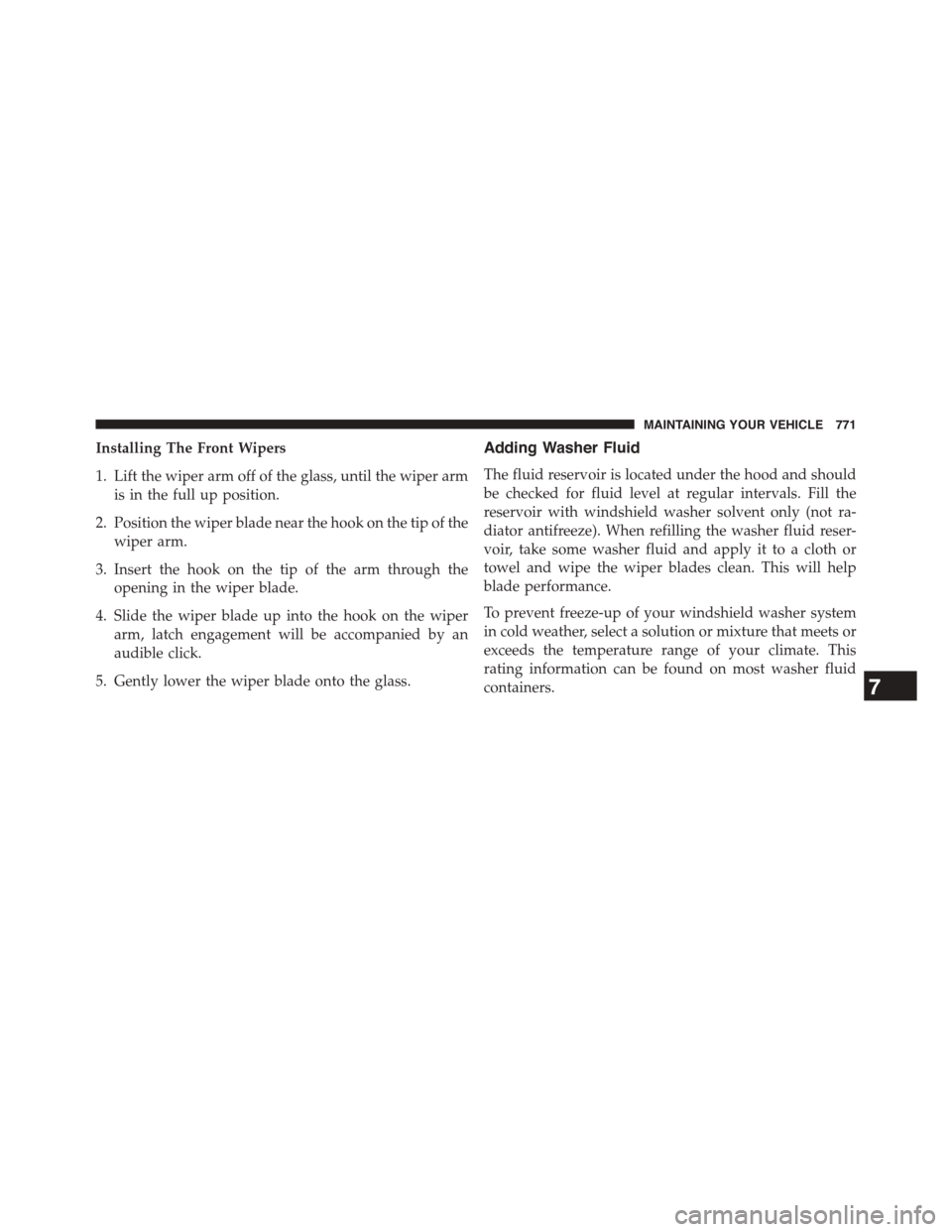
Installing The Front Wipers
1. Lift the wiper arm off of the glass, until the wiper arm
is in the full up position.
2. Position the wiper blade near the hook on the tip of the
wiper arm.
3. Insert the hook on the tip of the arm through the
opening in the wiper blade.
4. Slide the wiper blade up into the hook on the wiper
arm, latch engagement will be accompanied by an
audible click.
5. Gently lower the wiper blade onto the glass.
Adding Washer Fluid
The fluid reservoir is located under the hood and should
be checked for fluid level at regular intervals. Fill the
reservoir with windshield washer solvent only (not ra-
diator antifreeze). When refilling the washer fluid reser-
voir, take some washer fluid and apply it to a cloth or
towel and wipe the wiper blades clean. This will help
blade performance.
To prevent freeze-up of your windshield washer system
in cold weather, select a solution or mixture that meets or
exceeds the temperature range of your climate. This
rating information can be found on most washer fluid
containers.7
MAINTAINING YOUR VEHICLE 771
Page 774 of 871

WARNING!
Commercially available windshield washer solvents
are flammable. They could ignite and burn you. Care
must be exercised when filling or working around
the washer solution.
After the engine has warmed up, operate the defroster for
a few minutes to reduce the possibility of smearing or
freezing the fluid on the cold windshield. Windshield
washer solution used with water as directed on the
container, aids cleaning action, reduces the freezing point
to avoid line clogging, and is not harmful to paint or trim.
Exhaust System
The best protection against carbon monoxide entry into
the vehicle body is a properly maintained engine exhaust
system.
If you notice a change in the sound of the exhaust system;
or if the exhaust fumes can be detected inside the vehicle;
or when the underside or rear of the vehicle is damaged;
have an authorized technician inspect the complete ex-
haust system and adjacent body areas for broken, dam-
aged, deteriorated, or mispositioned parts. Open seams
or loose connections could permit exhaust fumes to seep
into the passenger compartment. In addition, have the
exhaust system inspected each time the vehicle is raised
for lubrication or oil change. Replace as required.
772 MAINTAINING YOUR VEHICLE
Page 831 of 871

NOTE: 1500 Models Only
•Under no circumstances should oil change intervals
exceed 10,000 miles (16,000 km) or twelve months on
1500 trucks, whichever comes first.
2500 – 3500 Models
•Under no circumstances should oil change intervals
exceed 8,000 miles (13,000 km) or twelve months on
2500 – 3500 trucks, whichever comes first.
Severe Duty All Models
•Change Engine Oil at 4000 miles (6,500 km) if the vehicle
is operated in a dusty and off road environment. This
type of vehicle use is considered Severe Duty
Once A Month Or Before A Long Trip:
•Check engine oil level
•Check windshield washer fluid level
•Check tire pressure and look for unusual wear or
damage. Rotate tires at the first sign of irregular wear,
even if it occurs before the oil indicator system turns on.
•Check the fluid levels of the coolant reservoir, brake
master cylinder, power steering (2500/3500 Models
Only) and automatic transmission (six-speed only)
and fill as needed
•Check function of all interior and exterior lights
8
MAINTENANCE
SCHEDULES
MAINTENANCE SCHEDULES 829
Page 853 of 871

Automatic............................410
Cold Weather Operation....................451
Compact Disc (CD) Maintenance..............397
Compact Spare Tire........................615
Console, Overhead........................212
Contract, Service..........................841
Coolant Pressure Cap (Radiator Cap)...........778
Cooling System...........................774
Adding Coolant (Antifreeze)...............776
Coolant Capacity.......................819
Coolant Level..........................775
Disposal of Used Coolant.................778
Drain, Flush, and Refill...................775
Inspection............................779
Points to Remember.....................781
Pressure Cap..........................778
Radiator Cap..........................778
Selection of Coolant (Antifreeze).............776
Corrosion Protection.......................790
Cupholders.............................234
Customer Assistance.......................839
Customer Programmable Features.............375
Data Recorder, Event.......................82
Daytime Running Lights....................168
Dealer Service............................754
Defroster, Rear Window.....................245
Defroster, Windshield......................116
Delay (Intermittent) Wipers..................179
Differential, Limited-Slip....................551
Dipsticks
Power Steering.........................577
Disabled Vehicle Towing....................740
Disposal
Antifreeze (Engine Coolant)................778
Door Locks
Door Locks............................37
Key Fob . . . . . . . . . . . . . . . . . . . . . . . . . . . . . . .3710
INDEX 851
Page 868 of 871
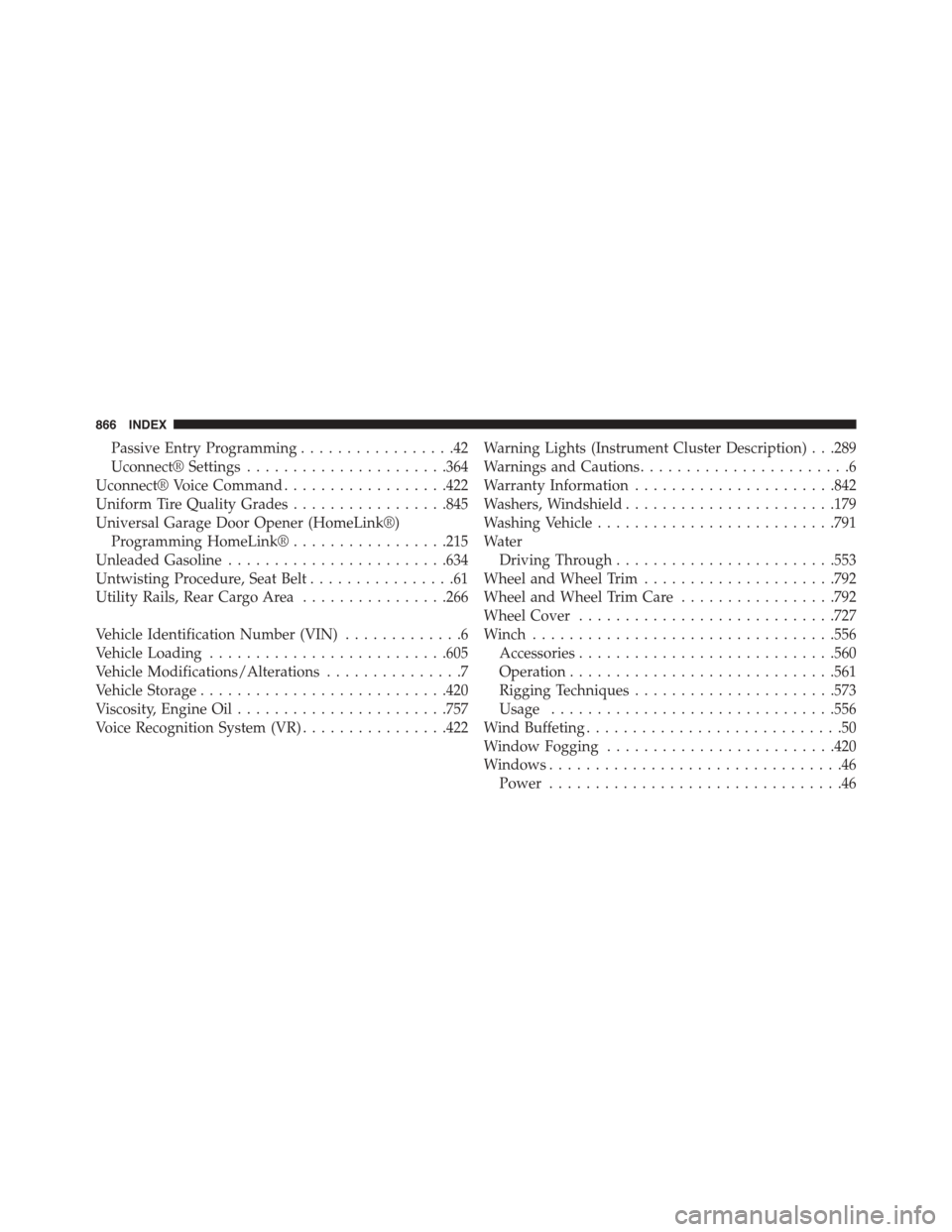
Passive Entry Programming.................42
Uconnect® Settings......................364
Uconnect® Voice Command..................422
Uniform Tire Quality Grades.................845
Universal Garage Door Opener (HomeLink®)
Programming HomeLink®.................215
Unleaded Gasoline........................634
Untwisting Procedure, Seat Belt................61
Utility Rails, Rear Cargo Area................266
Vehicle Identification Number (VIN).............6
Vehicle Loading..........................605
Vehicle Modifications/Alterations...............7
Vehicle Storage...........................420
Viscosity, Engine Oil.......................757
Voice Recognition System (VR)................422
Warning Lights (Instrument Cluster Description) . . .289
Warnings and Cautions.......................6
Warranty Information......................842
Washers, Windshield.......................179
Washing Vehicle..........................791
Water
Driving Through........................553
Wheel and Wheel Trim.....................792
Wheel and Wheel Trim Care.................792
Wheel Cover............................727
Winch.................................556
Accessories............................560
Operation.............................561
Rigging Techniques......................573
Usage...............................556
Wind Buffeting............................50
Window Fogging.........................420
Windows................................46
Power................................46
866 INDEX
Page 869 of 871
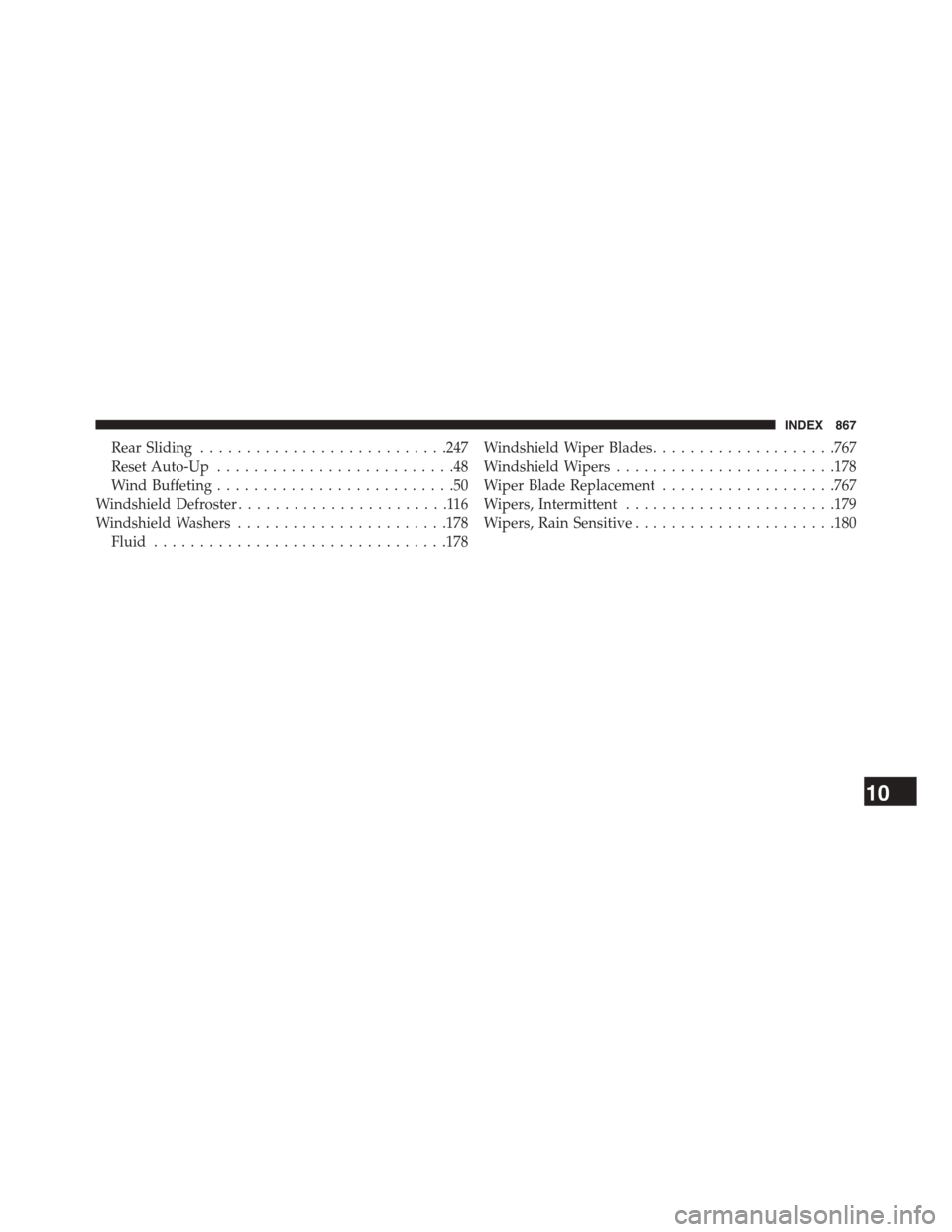
Rear Sliding...........................247
Reset Auto-Up..........................48
Wind Buffeting..........................50
Windshield Defroster.......................116
Windshield Washers.......................178
Fluid................................178
Windshield Wiper Blades....................767
Windshield Wipers........................178
Wiper Blade Replacement...................767
Wipers, Intermittent.......................179
Wipers, Rain Sensitive......................180
10
INDEX 867